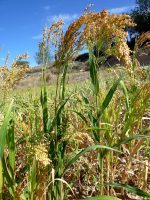 Also known as proso millet, broomcorn millet, hog millet, red millet, and white millet, this warm weather annual grass is native to northern China and is a member of the grass family, Poaceae, that also includes corn, bamboo and rice. Plants are often branching at the base and grow 6″-3′ tall with a stout stem and a spreading fibrous root system. The leaf sheaths have long spreading hairs, but the leaves are smooth or less hairy and 12″ long or more. Spikelets are carried in panicles 3-10″ long from early summer to autumn. The fruit is a grain that is white to yellow, orange or reddish brown and has a sweet nut-like flavor. Known for its extremely short lifecycle, low water requirements, and high disease resistance, proso millet is a valuable intercrop in the US and used for livestock and bird feed. The genus name, Panicum, is the Latin name for the grass. The specific epithet, miliaceum, comes from the Latin word milia meaning thousands and refers to the huge number of seeds produced by the plant. Type: Annual grass
Also known as proso millet, broomcorn millet, hog millet, red millet, and white millet, this warm weather annual grass is native to northern China and is a member of the grass family, Poaceae, that also includes corn, bamboo and rice. Plants are often branching at the base and grow 6″-3′ tall with a stout stem and a spreading fibrous root system. The leaf sheaths have long spreading hairs, but the leaves are smooth or less hairy and 12″ long or more. Spikelets are carried in panicles 3-10″ long from early summer to autumn. The fruit is a grain that is white to yellow, orange or reddish brown and has a sweet nut-like flavor. Known for its extremely short lifecycle, low water requirements, and high disease resistance, proso millet is a valuable intercrop in the US and used for livestock and bird feed. The genus name, Panicum, is the Latin name for the grass. The specific epithet, miliaceum, comes from the Latin word milia meaning thousands and refers to the huge number of seeds produced by the plant. Type: Annual grass
Bloom: Spiklets in panicles from early summer to autumn
Size: 6′-3′ H
Light: Full sun
Soil: Average, dry to medium moist, well-drained
Care: Remove weeds promptly
Pests and Diseases: None of significance
Propagation: Seed
Companion Plants: Often used as intercrop with crops such as winter wheat.
Outstanding Selections: Many varieties are available that vary in shape and structure of the panicle and the color of the seed.
Photo Credit:Wikipedia